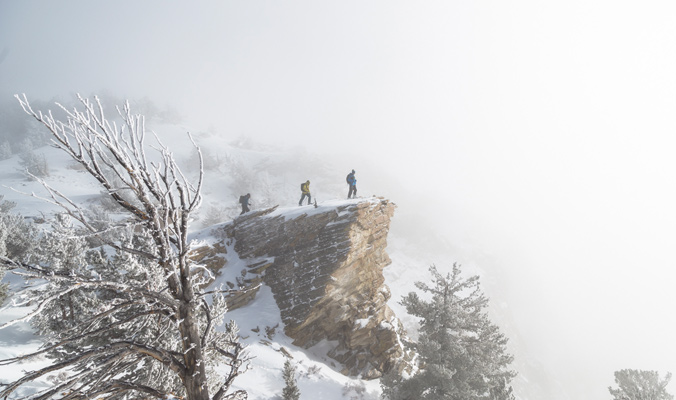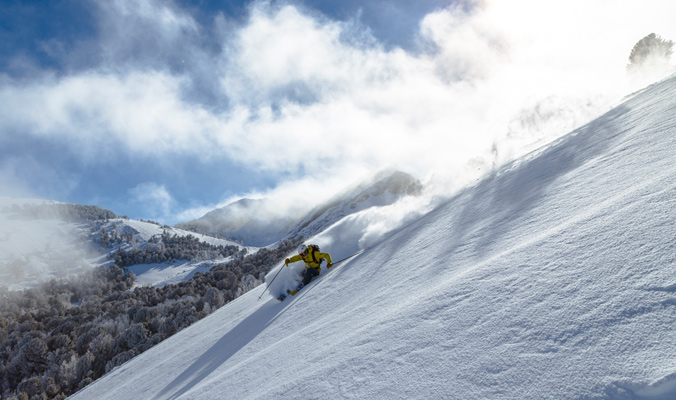There’s something telling about the Royers’ smiles. Joe’s is a bit angled, splitting wisely through his weathered complexion. His wife Francy’s is strong, welcoming and motherly. And their son Mike’s cracks broadly in a youthful, indelible grin.
They have plenty of reasons to be smiling. As the family behind Lamoille, Nevada’s Ruby Mountains Helicopter Experience celebrates their 40th season of operation this winter, they’re on the verge of a major expansion that includes bringing yurt-based touring to Nevada’s quietest couloir-packed mountain range.

Mike Royer surveys his family’s tenure from atop the Talbot Creek Drainage. [Photo] Mary McIntyre
Squarely between Salt Lake City, Utah and Reno, Nevada along Interstate 80 lies a long, 60-mile-wide valley below two of Nevada’s 400 mountain ranges—the Independence Range and the Ruby Mountains. In the 1970s, Joe Royer would drive between his home in Marin County, Calif. and his ski patrol job at Utah’s Snowbird Resort and muse about skiing the toothy peaks along the south wall of the Great Basin.
“From pretty much day one, I would drive back and forth and say, ‘Wow. This one [range] is beautiful,’” Joe, 66, says while eating raclette that Francy, 58, has prepared in their Lamoille home. He began exploring the mountains and became captivated by the remoteness of the range now synonymous with the Terminal Cancer Couloir—a plumb line that looks like an elevator shaft, dropping between high, straight walls of brown rock. “You’d leave in the dark and come home in the dark, and you might get to the bottom of a ski run,” he says. “It was awesome. There was nobody to ask. You’d have to figure things out for yourself. And we’re still figuring it out.”
In 1977, along with business partners Binx Sandahl and Carl Fischer, Joe founded what’s now one of the longest continuously running heli ops in the U.S. That first year, they had just 17 guests over a short season that started on St. Patrick’s Day. But through the subsequent decade, business swelled to 32 guests every three days, and Joe became the sole owner of Ruby in 1981 before meeting his future wife and business partner.
After graduating from The Art Institute in Boston, Mass., Francy Vitch was working as a pastry chef at Deer Valley when she joined a group of friends on a trip to the Rubies. Joe was her guide, and they connected over three days of good food and skiing, later developing a long-distance relationship before she moved to Lamoille in spring 1985. That October, the day after a two-foot snowstorm, the couple was married at Alta’s Rustler Lodge.
Mike, who’s spent the majority of his 26 years in the Rubies, laughs when his parents talk about falling in love. “My dad always told me you have to go four hours to find resort skiing,” he says, “and you have to go four hours to meet girls.”
Now that Mike’s just finished a journalism degree at Utah State University in Logan, skiing at resorts and meeting girls is less on his mind as he goes all in on the family business. And the family has gone all in on their offerings, too, doubling their investment in this 80-mile-long slice of Nevada backcountry. In March 2015, they purchased 1,109 acres of their 200,000-acre guiding tenure; they recently broke ground on a 10-room, four-season guest lodge (guests currently stay in a home the Royers rent on a Lamoille ranch), and they’ve constructed two yurts—with plans for at least three more—as part of a new heli- and cat-assisted touring package to capture a demand for high-end bc lodging.
“We’re kind of in a bit of a transition period,” Francy says. “A lot of these projects are inspired by the youth. Recently, Mike came to us and said, ‘I want to do this.’ We’re all really, really close, and for him to take this dream and want to carry it on is a win/win.”
Speaking of winning, Joe says the Great Basin snowpack is presently at 170 percent of average—a blessing after a few dry years. It’s late January, and their guides will arrive in a few days for the season, which begins in a week. So tomorrow, while we tour with Mike around their 10,000-foot yurt, Joe will be driving a snowcat, cutting roads for the season’s first clients. But first, they’re expecting eight inches of snow overnight.

The author drops in on the Royer’s family business. [Photo] Mary McIntyre
Ruby Mountains’ staging area, until they finish their new lodge in January 2017, is a small cabin near 7,000 feet overlooking Elko, Nevada’s urban sprawl. A city of 18,000, Elko is a ranching and mining community—the area is home to two of the world’s largest gold mines, and the range got its name from the garnet that early miners mistook for rubies in these mountains. And while not many residents ski, they appreciate the precipitation that winter brings.
“Everybody loves snow around here, with all the ranching,” Mike says, stepping into the cab atop the back of a polished red snowcat. The sky above is a moody gray, and while it didn’t snow the predicted eight inches, Joe expects it to clear and thinks last night’s winds likely deposited plentiful fresh on the slopes we’re planning to ski.
It’s a half-hour ride to their 10,000-foot yurt, and as Joe drives, Mike speaks more about the mounting interest for mechanized-assisted touring into the remote Rubies, their future plans for wintertime yurt-based avalanche and guiding courses and for summertime mountain-bike trails. “It would be awesome. It would be unreal,” he says, a grin spreading excitedly across his face.

Thom Pete partway down Terminal Cancer. In the early 1980s, Joe Royer said the only person crazy enough to ski the line would have been totally nuts or have had terminal cancer. He later claimed the first descent. [Photo] Mary McIntyre
Twisted, old-growth pines surround the yurt that’s perched near a south-facing precipice overlooking the Talbot Creek Drainage, one ridge over from the range’s most well-known valley, Lamoille Canyon. We exit the cat into the head of the Conrad Creek Drainage, and Joe motions throughout the surrounding valleys that they now own. “This is all private land, from this creek all the way through the next drainage,” he says. “It’s a dream come true, man.”
Mike points toward a north-facing line in Talbot Creek dotted with timber up high and banded diagonally by cliffs. “We call it Double Century or Double Oh,” he says, “’cause it takes 200 turns to get to the bottom.” Part of Talbot Creek borders the 90,000-acre Ruby Mountain Wilderness, and while they don’t land helicopters in the area due to mechanized restrictions, they hope to ski tour throughout the Wilderness more in the future. “That’s the plan, to put another yurt over there,” Mike adds.
Rather than dropping into the committing Talbot, we opt for an open, northeast-facing run below the yurt. Like Joe predicted, winds transported a foot of snow onto the clean slope, and I slide off the ridgeline into shin-deep fluff that rooster tails behind me at each turn. As I cut smooth arcs through the rippled surface, fog rises and falls, silhouetting long shadows around the pines. The slope pitches steeply near the bottom and the light snow erupts around my chest when I drop into each turn’s apex.
At the run’s bottom, we pull out skins and transition to tour mode while the fog lifts, allowing bright sunshine to illuminate the fresh snow like glitter. We skin back toward the yurt for another lap when, after 10 minutes, Joe drives up in the cat and offers a ride, to which Mike obliges.
Back on the ridge between Talbot and Conrad Creeks, Mike plans to set a skintrack eastward toward a peak he calls Tutti Fruti. On a typical day, he says, he’d guide clients into one of its many drainages on a six or seven-hour tour.
“I would be careful up there,” Joe says to Mike from the cat’s driver-side window, sounding at once fatherly and like a supervisor, expressing concern over windloading. “I gotta put these roads in,” he quickly adds before buzzing off.
Mike says the ridge walk between Talbot and Conrad is one of his favorite places in the Rubies, and as the cat’s diesel engine hums in the distance, he reflects on growing up in the family business, how he got his start taking out the trash, washing the helicopters and cats and eventually graduated to tail guiding and lead guiding, which he’s been doing for several seasons now.
“I’m an only child, but the guides were kind of like my older brothers…a lot of them still are,” he says. “I’ve always wanted to be a part of it, just kind of following in my parents’ footsteps. I really admire my dad’s work ethic, and my mom’s really great with people. They tell me that I got the best of both of them.”
Then he pauses on the ridge, surveying the surrounding valleys that seem to stretch in every direction. It feels a bit like that moment in The Lion King when Simba learns the entire kingdom will someday be his. But Mike’s probably known this, at least subconsciously, for a long time. And unlike survival of the fittest in Disney’s Pride Lands, the circle of Ruby Mountain life depends on hard work, good snow and the excitement and appreciation that Mike’s learned so well from his parents.
—
In late January, Joe, Francy and Mike Royer celebrated the 40th anniversary of Ruby Mountain Helicopter Experience with the official opening of their Ruby 360 Lodge. Find out more about all of Ruby Mountain’s offerings at helicopterskiing.com.










Mike Royer frequently sleeps with and has harassed female staff…this little boy is a fall down drunk who cant survive without his parents.